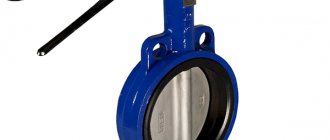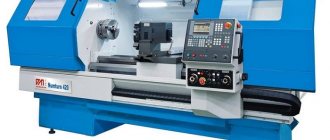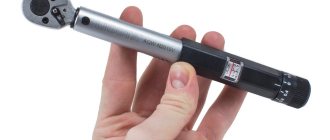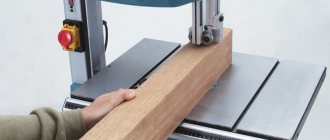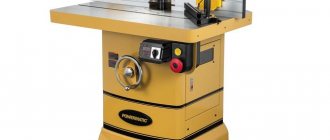Each carpentry workshop has a machine park. It is highly desirable to have a thickness planer available. This unit performs specific functions in the production of wood products. It can significantly facilitate and speed up the production of products.
What is a wood planer?
Wood is supplied to production in the form of boards, beams, and so on cut with a circular saw. To make workpieces suitable for further production from raw material, you need to process the surface more or less smoothly and maintain the size. A woodworking thicknessing machine is designed to give a wooden board the required thickness in one pass. The second function is to make the surfaces parallel. The output is a panel with two even, smooth sides and a given size in diameter.
Thicknesser for wood - device
The unit has a design similar to a jointer, but with some fundamental differences. The structure of a thicknessing machine for wood consists of the following blocks and mechanisms:
- a massive frame on which the assembly units are attached;
- drive consisting of an electric motor (one or two), sprockets, pulleys, drive chains and belts;
- working surface;
- feed rollers;
- shaft with knives;
- spring pressure mechanism;
- screw device for setting cutting thickness;
- sawdust suction system.
Thicknessing machines of industrial production are always equipped with a massive cast iron frame. The cylindrical cutter shaft can have up to four removable blades secured in the drum body with screws. The work table is guaranteed to have a length greater than 0.1 m according to TB requirements. Depending on the type, there are movable and fixed. Rollers move the workpiece during processing.
Thicknesser for wood - operating principle
The cutting knives are installed on top of the workpiece. The unit pulls the workpiece through feed rollers. They are installed below. Top mounting option available. The operator only performs the initial feeding and receiving of the processed part. The home workshop wood planer has an aluminum frame to reduce weight. The operating principle is the same as the industrial one. It doesn't make the side even. Initially, the curved workpiece will remain arched, only it will be calibrated in height.
What is a thicknesser, its functions and design
It is correctly called a “thicknessing machine”. We make markings or planing relative to one base. Makita 2012 nb. A review will be made and some of its features, pros and cons will be discussed.
First, let's look at what a thickness planer is for, what can this tool do? This is necessary because to this day there are questions, for example, why do I need a jointer if I have a thickness planer. That is, people are sure that if we put some kind of board into this tool, then it doesn’t matter how crooked or even it is, the output we get is perfectly calibrated. This is a deep misconception, ignorance of the principle of operation of a thickness planer.
Let's consider the theoretical part and the school geometry course. These are tools for calibrating lumber by thickness. It does not level the workpiece, it can trim it slightly, but it cannot make a base. The only task is to plan the board and ensure the same thickness along the entire length and width.
Thicknesser for wood - characteristics
To use equipment in work, you need to know its qualities. A household thicknessing machine for wood has the same characteristics as a unit for large-scale production, except for the position of different thicknesses. Indicators have different values depending on the brand. For industrial designs, the following basic values exist:
- width of the treated surface (up to 800 mm);
- thickness (10-180 mm) and length (up to 400 mm) of the material;
- maximum removable layer (4 mm);
- difference in the thickness of several simultaneously processed parts (4 mm);
- the size of the cutting shaft in diameter;
- workpiece feed speed;
- number of engines.
Cost of knives
In addition to the equipment, you may need thicknesser knives. Their price is 4100 rubles. These are double-sided cutting elements for planing processing. Suitable for all types of wood. It is based on a pure-grade hard alloy with a cobalt content of 18%. Consumables can be re-sharpened, which guarantees a long service life. Knives are made from high-speed steel HSS. Their thickness, width and length are 1.5 x 332 x 12 mm, respectively. The package contains two cutting elements.
Why do you need a wood planer?
The primary processing of solid wood is jointing. The thickness planer will be used secondarily. First, the board is planed using a rotating shaft with knives, feeding it manually along the table surface. This makes one side flat without bending and smooth. The jointer has a side plane perpendicular to the table. The sidewall is processed on it, forming an angle of 90°. Having planed two sides, you get one right angle. To maintain strict perpendicularity at other angles, it is necessary to carry out many additional operations on this machine.
You can finish finishing corners faster, better and more accurately using a surface planer. It will remove exactly the layer that is set with the screw device. The machine will calibrate the workpiece parallel to the surfaced side. Then the second sidewall is processed. In two passes, three right angles are obtained. This is what makes a wood planer very useful in production. It is recommended to complete the processing by running the surfaced side through a thicknesser to prevent warping.
Design Features
The main task of jointing machines and planers is to ensure the beauty and quality of processing of the finishing part of the workpiece. They remove every defect and unevenness, which ensures an attractive aesthetic appearance and practicality of the product. The device can be used both in a home workshop and in a large enterprise that requires daily operations.
At the finish, a smooth and clean board comes out of the machine, preserving its natural structure. In some models, the functionality does not end there - they allow chamfering. It is important to remember that the wood must be completely dry before starting work. This is the main condition for trouble-free operation.
How does a thickness planer differ from a jointer?
Both machines are very similar to each other. A thicknesser and a jointer both plan. However, they differ in purpose and design. Purpose of jointer:
- primary processing of one side of a piece of solid wood until it is smooth to the touch;
- giving the surface of the workpiece a flat plane (without curvature);
- jointing the sidewall of a part to form a right angle.
The design of this machine involves installing a shaft with knives on the table. The cutting edges are located below the part. Feeding is carried out manually along the table plane. When working, you must use a special stop to push the workpiece. The operator is forced to press hard on the part to the end of the pass in order to obtain a flat surface.
Thicknesser is intended for:
- calibrating the thickness of a part according to a given value;
- ensuring parallelism of opposite sides.
The drum with knives is located on top of the wood board. This processing method requires significant effort to feed the workpiece. It will no longer be possible to push it manually, so the machine is equipped with upper or lower feed rollers. The movement of the part in the working area occurs automatically. This makes working on a thickness planer safer and makes the operator’s work easier. The disadvantage of the machine is that it does not provide a flat surface.
The best planes
DEWALT DW735X Two Speed Planer
DEWALT DW735X Two Speed Planer
Starting with this piece of equipment, we present a high-performance and durable planing machine. The three-knife cutter head gives a very powerful result. It is also a 20,000 rpm engine. With a two-speed gearbox, users can change the feed speed to optimize cutting. The maximum cutting depth is 1/8" with a full capacity of 6" deep and 13" wide.
The downside to this plane comes in two forms: price and weight. It's on the higher end of the price spectrum, making it a serious investment. That's why it's ideal for the professional or intensive user. The three blades also have a short lifespan with high replacement costs. Some reviewers have chosen to purchase different knives to get better results, but that would be a separate purchase based on individual needs.
On the other hand, the DeWalt plane will also provide reliable customer service and a three-year warranty. Reviews of the planer highlight the customer service and quality of the equipment, with 75% of those surveyed giving it five stars. Most reviews indicate that it is worth the price tag.
DEWALT DW735X Pros
- 20,000 rpm
- Cutter head with three knives
- Two-speed gearbox
- Ideal for professionals
- 3 years warranty
DEWALT DW735X Cons
- Weight is not suitable for portability
- High price
- Replacement knives are expensive
DEWALT Jointer, 2 Speed, 13" (DW735X)
- Powerful 15 AMP, 20,000 RPM motor (10,000 RPM cutter head speed) easily handles large cuts in wider materials
- Three-knife cutting head extends knife life by 30 percent, fan pushes chips out of chip head and pulls them out of machine
- Two-speed gearbox allows users to change feed speed to optimize cuts per inch at 96 or 179 CPI
- Maximum cutting depth 1/8" x 6" deep x 13" wide
- Includes feeding and unloading tables and an additional set of knives. Reduce feed rate to 14 ft/min. Aircraft type: stationary
Makita 2012NB 12" machine
Makita 2012NB 12" machine
In contrast to the weight of the DeWalt DW735X is the Makita 2012 NB. This machine has a compact design, which enhances its portability. If the project needs transportation to different job sites, this is a good option. It also has a low noise level, making it more convenient and safe to use. For safety purposes, the machine is equipped with an LED light to indicate when it is connected to power and ready to use.
Don't let the size fool you - this is still a powerful piece of equipment. The Makita has an 8500 RPM motor and a maximum entry width of 12 inches. The cutting depth is 1/8 inch. The planning depth is 1/16 inch. Reviews indicate that it is easy to use, making it a suitable choice for new woodworking businesses. It has a one-year warranty. This purchase comes with dual planer blades, wrenches and a tool box.
Like the DeWalt DW735X, the downside is the price. However, there are several financing options available at some retailers. The dust collection hood is also sold separately, creating another purchase. Some reviews also report that replacing the blade can be difficult.
Makita 2012NB Pros
- Engine 8500 rpm
- Compact design suitable for transport
- Low noise level
- 1 year warranty
Makita 2012NB Cons
- Expensive
- Dust collection hood sold separately
DEWALT DW734 15 Amp 12-1/2" Tabletop Planer
DEWALT DW734 15 Amp 12-1/2" Tabletop Planer
Say hello to the powerful DeWalt DW734. This tabletop planer has 20,000 RPM and is capable of processing large, deep cuts in hardwood. It also has a 3-knife cutter head with disposable and reversible steel blades. The power of this planer is 96 cuts per inch, one of the best in portable planers.
In addition to its power, the price is also well suited to many budgets. This is an excellent alternative to more expensive models on the market. It is durable and designed to last for many projects. Most planer reviews show that it is a solid investment for woodworking businesses. It also comes with a 3-year warranty.
Of course, there are also disadvantages. Like the DW 735, this planer is best suited for benchtop use. It's heavy despite being considered portable. Standard blades wear out over time and require replacement. Some reviews indicated that the dust collection system left much to be desired.
DEWALT DW734 Pros
- 20,000 rpm
- Cutter head with three knives
- Price guide
- 3 years warranty
DEWALT DW734 Cons
- Weight is not suitable for portability
- Dust collection system
- Replacement knives are expensive
DEWALT Tabletop Planer, Single Speed, 15 Amp, 12-1/2-Inch (DW734)
- Three blade cutting head with 10,000 rpm rotation speed produces 96 cuts per inch, one of the best options for any portable plane
- Disposable, reversible knives increase knife life by 30 percent and allow for quick and easy knife replacement
- Four-column carriage lock dramatically reduces movement that causes sticking
- Extra long feed and exit tables provide 33-1/2 inches of material support
- Powerful 15.0A, 20,000RPM motor handles larger, deeper cuts in hardwood.
Delta Power Tools 22-555 Portable Thickness Planer
Rotary hammer Delta Power Tools 22-555
For smaller projects or more casual users, there is the Delta planer. This model has a small but powerful 15 amp motor, ideal for a small shop. The maximum cutting depth is 3/32”; The maximum feeding width is 13 inches. It has adjustable feed and discharge to reduce trimming and handle long pieces. Knives with double blade and disposable. It has a low price, which makes it very profitable. It is accurate and durable, with easy blade changes and low shot production. It also comes with a five-year limited warranty from a reputable brand: Delta has been in business for almost 90 years!
This part is suitable for the more casual user, as its lack of power is not suitable for professional or heavy users. It is not powerful enough to handle harder woods. Considering the price, warranty and intended use, this would be a safe purchase.
Power tool Delta 22-555 Pros
- 15 amp motor
- Double knives
- Low price
- Five-year warranty
- Good for the average user
Power tool Delta 22-555 cons
- Not powerful enough for professional or heavy user
- Not suitable for harder woods
Delta 22-555 13 power tool in portable planer
- Powerful 15A motor capable of handling the most difficult tasks
- Four-column design provides superior stability for smooth, precise gliding
- Quick-change knife system with disposable dual-blade knives allows knives to be changed without the need for complex centering devices
- Adjustable infeed and outfeed tables to better support long parts and reduce sniping
- The reversible dust collector allows you to collect chips from the right or left side of the planer. Machine Dimensions: 21-5/8 x 23-5/8 x 20-1/8 inches
WEN 6552 3-blade tabletop planer
WEN 6552 Tabletop Planer with 3 Blades and 15 Amp
Another option for the casual user or beginning woodworker is the WEN Model 6552. This 15-amp motor can handle flat boards up to 6 inches thick and 13 inches wide. The engine is capable of producing 25,500 cuts per minute. The three-blade design makes it easy to work with all types of wood—even hardwood. It also comes with a 2-year warranty and weighs 66 pounds: on the lighter side for planers. WEN products are also supported by a network of service technicians throughout the country.
The purchase also comes with a cast iron base, height-adjustable inlet/output tables, dust port with fan, and more. The auxiliary fan is great for removing shavings and sawdust from your work area. The combination of cast iron base and onboard planer creates a durable planer—no need to worry about wobbly operation. This model is also a great price, and reviewers indicate that quality doesn't sacrifice price.
The size and power of this planer are not suitable for professional use. The home or casual user will benefit greatly from this purchase.
WEN 6552 Pros
- Powerful 15 amp motor
- Capable of 25,500 contractions per minute
- Three-blade design
- Capable of processing various types of wood
- Price guide
- 2 years warranty
WEN 6552 Cons
- Size and power not suitable for professional use
WEN 6552 15 Amp 3-Blade Planer, 13"
- Built-in material removal sensor informs users of the cutting depth of each pass
- Flat boards up to 6" thick and 13" wide
- 15A motor generates 25,500 cuts per minute with a feed rate of 8m per minute
- Three-blade design makes it easy to work in even the toughest woods
- Dust vent removes sawdust from workpiece
Types of thicknessing machines
There are many designs designed for use in different operating conditions depending on the needs and production volumes. According to power they are distinguished:
- industrial stationary;
- mobile for large production;
- medium power for carpentry workshops;
- mini planer for wood.
According to the number of surfaces processed:
- one-sided;
- double sided;
- multilateral.
Machines with one (upper) processing plane are used in everyday life and in small industries. The class of professional equipment includes units with two- and multi-sided simultaneous planing of planes. Double-sided analogues have two knife shafts. They work on two opposite sides at once in one pass. Multilaterals are convenient in that they can create a workpiece configuration of any shape. Disadvantages include difficulty in maintenance and repair. However, a planer for wood of this type in large-scale production fully covers all costs.
Description
Quite often, novice craftsmen do not know what a surface planer is. If you, too, are among them, then you must understand: the device described is equipment with a cutting tool in the form of a knife shaft. The workpiece is fed along a horizontal table, which is the working table in the machine.
Today, single-sided and double-sided machines are known. The former have one knife shaft, which is designed to remove material from the upper part. Double-sided devices have an additional blade shaft located on the work table. The element is based on the surface, and if fixation is necessary, it is carried out by a bar and side rollers. Retention is provided by rollers that facilitate feeding. The latter can also be manual. A double-sided thicknesser machine is similar in design features to jointing equipment, so such units are often combined, which makes it possible to obtain jointer-thicknesser devices.
How to choose a planer for wood?
Depends on operating conditions and production goals. To answer the question of how to choose a thickness planer, you need to know:
- electric motor power;
- functional features (how many sides it processes);
- basic processing parameters.
Having learned the preliminary characteristics, you can consider the design of the machine in more detail:
- The digital display is preferred.
- Feed rollers made of polymer do not track on wood.
- What type of knife mechanism is it?
- Convenient handles make it easy to carry.
- Does the home planer have a sawdust removal system?
Knives of thicknessing machines
There are different designs depending on the shaft design. It comes with a straight knife arrangement and a screw arrangement. The second type of shaft cuts into the wood smoothly, without impact. Allows you to achieve improved processing quality and reduced noise during operation. The disadvantage is the difficulty of installing many cutting elements.
Knives for thicknessing machines are divided into:
- flat straight with angular sharpening;
- thick two-layer;
- thin crescent-shaped for screw shafts.
The need to use a chip extractor
Woodworking thicknessers throw out large volumes of shavings during operation. It is best to remove it using a construction vacuum cleaner. If this is not done, waste will clog in the equipment. They penetrate the moving mechanisms and enter the planing area. All this reduces the quality of processing.
As a result, the master is unable to obtain a smooth surface of the workpiece. In support of the need to use a lumber waste disposal device, cleanliness in the workplace is also important.
Thicknesser for wood - rating
The choice was made based on the main characteristics and owner reviews posted on several specialized sites. Rating of thicknessing machines:
- Metabo DH 330
. The double-sided machine produces mirror-like surfaces at the output. - Special SRM-2000
. Along with other quality characteristics, it is lightweight, which is convenient when working outdoors. - Interskol RS 330-1500
. There are double-sided knives that can be swapped and work for a long time without sharpening. - Craton WMT 318
. Ensures reliable operation without significant repairs during daily operation for up to five years.
Do-it-yourself thicknesser for wood
It is quite possible to make the unit at home. Plan for how to assemble a thickness planer with your own hands:
- Select a kinematic scheme.
- Develop drawings of parts and assemblies (or find ready-made ones on the Internet).
- Weld a rigid metal frame.
- Mount the feed rollers.
- The unit with the cutting shaft is equipped with an adjusting screw.
- The table can be made from an oak slab and bolted to the frame.
- Install the drive by connecting the V-belt and chain drives.
- A vacuum cleaner can be used for the sawdust removal system.
- The first start is made at idle.
How to use a thickness planer?
Proper operation of the equipment will allow you to obtain excellent products for a long time. A thickness planer for wood requires a certain procedure:
- Before work, inspect the exterior for any visible defects.
- Make sure the hood is connected.
- Apply voltage. All lights, indicators and display screen (if equipped) should be illuminated.
- Let it idle.
- Use the adjusting screw to set the desired thickness.
- Put on safety glasses, turn on the machine, and feed the workpiece onto the rollers.
- Accept the outgoing part.
